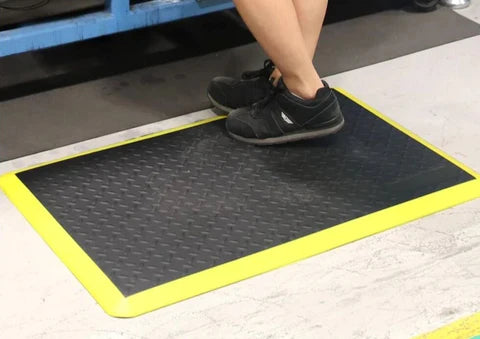1. Introduction
Fatigue mats are unsung heroes in environments where prolonged standing is necessary, such as workplaces, kitchens, and industrial settings. These mats are designed to reduce fatigue and discomfort associated with standing for extended periods, thereby improving comfort and productivity. In this article, we explore the features, benefits, and applications of fatigue mats in various settings.
2. What are Fatigue Mats?
Fatigue mats, also known as anti-fatigue mats, are ergonomic flooring solutions crafted from materials like rubber, foam, or gel. They are specifically engineered to provide cushioning and support to individuals standing for long durations, effectively reducing strain on the feet, legs, and lower back.
3. How do Fatigue Mats Work?
Fatigue mats work by offering a supportive yet cushioned surface that promotes subtle movements of leg muscles. This encourages blood flow and reduces pressure points, preventing muscle fatigue and discomfort. The mats' shock-absorbing properties also alleviate stress on joints, contributing to overall comfort and well-being.
4. Types of Fatigue Mats
There are various types of fatigue mats available, catering to different preferences and requirements:
-
Foam Mats: Made from durable foam materials, these mats offer excellent cushioning and are lightweight and easy to move.
-
Rubber Mats: Constructed from resilient rubber compounds, these mats provide durability and resistance to oils, chemicals, and punctures, making them ideal for industrial environments.
-
Gel Mats: Featuring gel-filled cores, these mats offer superior cushioning and support, conforming to the contours of the feet for maximum comfort.
5. Features to Consider
When choosing fatigue mats, it's essential to consider the following features:
-
Thickness: Opt for mats with adequate thickness to provide sufficient cushioning without compromising stability.
-
Surface Texture: Look for mats with textured surfaces to prevent slips and enhance traction, especially in wet or oily environments.
-
Size and Shape: Select mats that suit the layout and size of the workspace, ensuring full coverage and seamless integration into the environment.
6. Benefits of Fatigue Mats
The utilization of fatigue mats offers several benefits:
-
Improved Comfort: Reduces fatigue and discomfort associated with prolonged standing, promoting better posture and overall well-being.
-
Enhanced Productivity: Minimizes downtime due to fatigue-related issues, allowing workers to focus on tasks for more extended periods.
-
Injury Prevention: Alleviates strain on joints and muscles, reducing the risk of musculoskeletal injuries such as back pain and leg fatigue.
7. Applications
Fatigue mats find wide-ranging applications across various industries and environments, including:
-
Retail: Used in cashier stations, customer service counters, and standing workstations to enhance employee comfort during long shifts.
-
Food Service: Employed in kitchens, food preparation areas, and dishwashing stations to provide relief for chefs, cooks, and kitchen staff.
-
Manufacturing: Utilized in assembly lines, packaging areas, and workstations to reduce fatigue and improve worker productivity in industrial settings.
8. Safety Considerations
While fatigue mats offer numerous benefits, it's crucial to consider safety aspects:
-
Slip Resistance: Ensure that mats have adequate traction and meet safety standards to prevent slips and falls, especially in areas prone to moisture or spills.
-
Edge Stability: Choose mats with beveled or tapered edges to minimize tripping hazards and facilitate smooth transitions between surfaces.
-
Regular Maintenance: Regularly inspect and clean mats to remove dirt, debris, and spills that could compromise safety and performance.
9. Maintenance and Care
To prolong the lifespan of fatigue mats and ensure optimal performance:
-
Regular Cleaning: Clean mats regularly using mild detergent and water, then allow them to air dry thoroughly before reuse.
-
Avoid Harsh Chemicals: Refrain from using harsh chemicals or abrasive cleaners, as they may damage the mat's surface or reduce its effectiveness.
-
Rotate Mats: Rotate mats periodically to distribute wear evenly and extend their longevity.
10. Choosing the Right Mat
Selecting the appropriate fatigue mat depends on factors such as the environment, intended use, and user preferences. Consider consulting with a knowledgeable supplier or conducting trials to determine the best fit for your specific needs.
11. Common FAQs
Q1: Can fatigue mats be used on all types of flooring?
Fatigue mats are versatile and can be used on various flooring surfaces, including tile, concrete, hardwood, and laminate. However, it's essential to ensure compatibility and proper adhesion to prevent slipping or movement.
Q2: How thick should a fatigue mat be for optimal comfort?
The ideal thickness of a fatigue mat depends on factors such as the user's weight, duration of use, and personal preference. Generally, mats with a thickness of 3/8 to 3/4 inches offer adequate cushioning for most applications.
Q3: Are fatigue mats suitable for wet environments?
Yes, many fatigue mats are designed with non-slip surfaces and drainage holes to provide traction and prevent pooling of liquids, making them suitable for wet or oily environments such as kitchens and industrial settings.
Q4: Can fatigue mats alleviate lower back pain caused by standing for long periods?
Yes, fatigue mats help reduce strain on the lower back by promoting better posture and weight distribution, thus alleviating discomfort and reducing the risk of lower back pain associated with prolonged standing.
Q5: How long do fatigue mats typically last?
The lifespan of fatigue mats varies depending on factors such as usage intensity, environmental conditions, and maintenance practices. With proper care and maintenance, high-quality fatigue mats can last several years.
12. Conclusion
Fatigue mats play a vital role in enhancing comfort, safety, and productivity in environments where prolonged standing is necessary. By providing cushioning, support, and ergonomic benefits, these mats alleviate fatigue and discomfort, contributing to a healthier and more efficient work environment.

